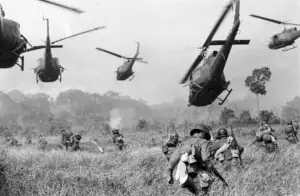The Great Plains, a vast expanse of grassland that stretches across the central United States and into Canada, has been the ancestral homeland of various Native American tribes. Known as the Plains tribes, these Native People have a rich and diverse history, deeply entwined with the geography and natural resources of the region. Their cultures, traditions, and ways of life offer an insightful glimpse into the complex and vibrant societies that thrived in the heart of North America.

✅ AI Essay Writer ✅ AI Detector ✅ Plagchecker ✅ Paraphraser
✅ Summarizer ✅ Citation Generator
The Lifeblood of the Plains: The Bison
For the Plains tribes, the bison, or buffalo, was more than just an animal; it was the cornerstone of their existence. Bison hunting was not only a means for food but also provided materials for shelter, clothing, and tools. The relationship between the Plains tribes and the bison was one of deep respect and symbiosis, reflecting a profound understanding of ecological balance.
Impact of Bison Extinction
The near-extinction of the bison in the 19th century, primarily due to excessive hunting by European settlers, had a devastating impact on the Plains tribes. The decline in bison populations led to significant changes in their way of life, forcing many tribes to alter their traditional nomadic patterns and adapt to new means of sustenance.
The Horse: A Catalyst for Change
The introduction of the horse, brought by European settlers, dramatically transformed the lifestyle of the Plains tribes. They quickly became master riders and warriors, with horse riding becoming integral to their culture. The mobility provided by horses revolutionized bison hunting and warfare, enhancing the tribes’ ability to traverse the vast Great Plains.
Diverse Languages and Communication
The Plains tribes spoke a variety of different languages, each unique to their respective groups. This linguistic diversity was a hallmark of their rich cultural heritage. In addition to spoken languages, many tribes also used sign language as a means of communication, especially when interacting with other tribes speaking different languages.
Ceremonial and Cultural Practices
Dances played a crucial role in the cultural and spiritual life of the Plains tribes. Ceremonial dances, such as the Animal Dance and Sun Dance, were central to traditional celebrations and religious ceremonies. These dances were not only forms of artistic expression but also means of connecting with spiritual realms and reinforcing communal bonds.
Preservation of Culture and Traditions
Despite the challenges faced, including relocation to reservations and the pressure of assimilation, the Plains tribes have strived to preserve their traditional celebrations and language. Efforts in language preservation and the revitalization of cultural practices continue to be vital in maintaining the unique identity of each tribe.
Life on Reservations
The forced relocation of Plains tribes to reservations drastically altered their traditional way of life. This shift often resulted in the loss of homelands rich in natural resources and vital to their cultural identity. Life on reservations posed new challenges but also became a ground for resilience and cultural renaissance.
Agriculture and Bison Restoration
With the decline of bison populations and the changes brought by reservation life, many Plains tribes turned to agriculture. Farming became an essential aspect of survival, requiring adaptation to new techniques and the cultivation of crops suitable to the region’s climate and grass growth.
Efforts in Bison Restoration
In recent years, there has been a concerted effort to restore bison populations in the Great Plains. This initiative is not just about bringing back a vital species but also about restoring a crucial element of the Plains tribes’ heritage and way of life. The resurgence of the bison symbolizes hope and renewal for these Native American communities.
Conclusion
The Plains tribes of the Great Plains region represent a remarkable chapter in the history of Native Americans. Their stories, from the vital role of the bison and the transformation brought by the horse to their rich languages, dances, and traditions, paint a vivid picture of resilience, adaptation, and cultural richness. Despite the trials and tribulations, including the impact of European settlers, the Plains tribes continue to preserve their unique heritage and contribute significantly to the diverse tapestry of American culture. Their ongoing efforts in cultural preservation and the restoration of the bison population stand as testaments to their enduring spirit and deep connection to the land and its natural resources.
FAQ
Follow us on Reddit for more insights and updates.





Comments (0)
Welcome to A*Help comments!
We’re all about debate and discussion at A*Help.
We value the diverse opinions of users, so you may find points of view that you don’t agree with. And that’s cool. However, there are certain things we’re not OK with: attempts to manipulate our data in any way, for example, or the posting of discriminative, offensive, hateful, or disparaging material.